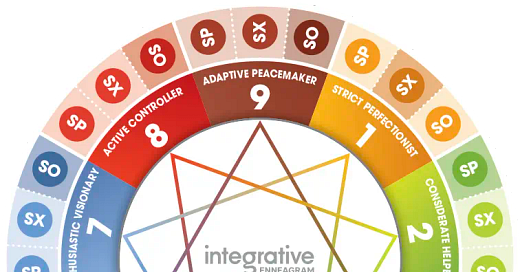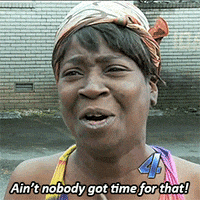How Subtypes Can Change Everything You Thought About Your Enneagram Number
The most useful part of the Enneagram you may not even know about
I could talk for hours and write for days about the Enneagram, and how its ins and outs are so helpful. The more you uncover, the more it changes what you previously thought about the different types.
I think it would take forever for me to break down the Enneagram for everyone the way I did the temperaments.
And I realize that not everyone has the time or energy to deep dive like that.
So I thought I would write about the easiest and the most practical part of the Enneagram…and it may be more helpful for you than simply learning your number.
I want to focus today on the three subtypes.
How Subtypes Can Help You Embrace Your Number
Honestly, I don’t know why more Enneagram teachers don’t teach these FIRST. Once you understand your subtype, it can clear up any confusion you have as to why you tested as a certain number even though you feel like you can’t relate to the description of that type.
For instance, there’s definitely no doubt I’m a type 9. However, after I learned about the nine types, and the more I talked with other 9s, the more I got confused. I wasn’t like a lot of them.
The picture painted of 9s is that they are quiet and reserved, and mostly introverted. While I can be those things to a degree, it’s no way to the level that most other 9s are.
I love being the center of attention. I love performing. I love public speaking. I have been doing improv comedy for nearly 20 years. I also love change and strange environments. There is a little reservation inside me, but I often have fun at parties where I’m meeting new people.
Most 9s wouldn’t be caught dead in those scenarios…at least, that’s what had been taught to me.
Then I learned that I am a social subtype, and that social 9s are the countertype. Then everything fell into place for me. It explained everything.
So let’s dive in and see if you can come to similar revelations…
What are the subtypes?
There are three different subtypes that one can be. Whichever one is dominant for you can dictate a lot about how you reflect your Enneagram number.
They have such an impact, that it often is the reason some people get mistyped and think they’re a different number.
In fact, if you ask an Enneagram teacher or coach how many Enneagram types there are, their answer will be 27, not nine.
That’s because every number manifests itself through the three subtypes. So there’s three types of each of the nine types.
Confused yet? Great! Let’s keep going.
Here are the three subtypes:
Social (SO)
Self-Preservation (SP)
Sexual (SX) [or, if that word makes you feel icky, One-on-One]
Everyone is dominant in at least one of these. Everyone is repressed in at least one. Some have two that are pretty high and can go back and forth. Some have one that is super dominant while the other two are real low. Most people probably have a clear dominant subtype, a “middle” (or neutral) subtype, and a repressed subtype.
A Breakdown of Each Subtype
»Social«
This is a highly relational subtype that is acutely aware of the “vibe” when in a group, and can accurately assess the status levels very quickly. This type loves being a part of a group that has a shared goal or harmonious balance. In other words, they love teams, and they love feeling like they belong to a tribe.
If this type goes to a party, they’ll feel like they had a good time after meeting and conversing with a lot of people, even if it never goes past small talk. They likely would prefer activities when the large group comes together, such as a game night, or parties where everyone is up and dancing.
It should be noted…social does not mean extroverted.
It simply means the lens through which they engage with people via their number is more focused on the group at large.
If someone is repressed in this subtype, it could look like they indeed are antisocial. But also, depending on their dominant subtype, it could simply mean they either put priority on themselves or have more of a desire to get to know a few people more deeply as opposed to a lot of people on a surface level.
»Self-Preservation«
This is the more inward subtype. Their focus is on their own safety and well-being. It may sound a little bad or icky when phrased that way, but it simply means that priority is putting your own mask on first before assisting those next to you, to use the airplane analogy. It’s a more responsible outlook.
SPs typically are more healthy, or more wealthy (due to shrewdness in building income security), or prioritize their own comfort. Under stress, they’ll likely kick into hoarding mode, especially when it comes to preserving energy.
If this type goes to a party, they likely will immediately assess where all the essentials are- the exits, the bathroom, the snack table, etc. They also will be most likely to hug the wall and not venture out into the crowd much. They’re likely gonna be the first to leave, too.
I suppose this should be said, too…self-preservation does not mean introverted.
If someone is repressed in self-pres, they are going to probably neglect themselves in an unhealthy way…be it physical fitness, money, sleep, mental health, etc. What they neglect it for will be dependent upon their dominant subtype.
As someone who is SO dominant and SP repressed, I am quick to throw caution to the wind if it means everyone still gets to hang out together. It’s 2am and you guys wanna go to Waffle House? Sure! I’ll probably do just fine on the test for my 8am class…
» Sexual «
Awwwww yeah. The sexiest subtype.
Okay, not really.
Sexual, or One-on-One dominant people simply are those who love to go deep. They love to experience things intensely, and really want to get to know the core or DNA of a person. SX types crave an energetic connection.
I think that’s why it’s called, “sexual.” It’s not because they are Pepé Le Pew and are trying to hook up with everyone (though I’d be willing to bet he’s an SX), it’s just that they want to feel deeply, and experience intimacy with the world around them.
Continuing the party analogy, this type will have a good time if they really connect with an individual. Again, it can be completely platonic. But if they found one or two people and talked to them for hours about deep, real topics, they will have an amazing night.
If they go to a party and everyone only talks about sports or the weather, and the SX didn’t really feel like they really got to know anyone, they will have a miserable time.
If you’re repressed in SX, then you’re likely going to struggle to maintain deep friendships. People low on this type tend to have a hard time revealing intimate details about their lives and tend to keep superficial relationships. It’s also likely that they struggle to be good conversationalists and rarely ask/talk about others.
Countertypes
I won’t go into all 27 types, because I think you can easily find that online (for instance, you can go here and scroll down to the black box that has the colorful, clickable numbers) if you want to deep dive or just read specifically for your number. But I do think it’s worth spending time on the subtypes that are the most confusing.
Since each Enneagram number has three different flavors depending on one’s subtype, one of the three subtypes will be that number’s countertype.
A countertype expresses itself differently in its number than the other two subtypes. Often, it can look like a contradiction and can confuse someone about their type.
So here are the countertypes for each number:
Social - 7, 8, 9
Self-Preservation - 2, 3, 4
Sexual - 1, 5, 6
If you’re a social 7, 8, or 9, you may have been mistyped as a 2 or 3.
If you’re a self-pres 2, 3, or 4, you may have been mistyped as a 6 or 7.
If you’re a sexual 1, 5, or 6, you may have been mistyped as a 4 or 8.
Social 7s are a countertype because they are more focused on other people and whether they are enjoying themselves, rather than engaging more directly in their vice (gluttony).
Social 8s are a countertype because their drive for power is used for lifting up others with them, rather than personal achievement and control.
Social 9s are a countertype because they jump in and take charge more (even become workaholics!), all for the purpose of creating more group harmony.
Self-Pres 2s are a countertype because instead of meeting the needs of others to gain love and acceptance, they have more of a desire to meet their own needs.
Self-Pres 3s are a counterype because they don’t like to advertise their strengths and achievements and don’t like to be seen as someone who cares about their image. They desire personal security and try to achieve it through their hard work.
Self-Pres 4s are a countertype because they are less likely to be outward in their emotions and pain and don’t like to share them with others.
Sexual 1s are a countertype because their perfectionism is outward more than inward. They seek to help others become “better” or fit their idealistic view.
Sexual 5s are a countertype because they seek knowledge and understanding through others, which leads them to be more open to those they trust (as opposed to being a “knowledge hoarder”).
Sexual 6s (also known as counter-phobic) are a countertype because they prefer fight to flight. They face their fears and go on the offensive instead of avoiding their fears.
Application
This was a brief overview/crash course. If you came away confused or have a bunch of questions, let me know in the comments!
Even if you only are sure of your subtype, it can help you understand the why behind a lot of your actions, and can especially help in relationships.
I mentioned that my subtype is social…my wife’s subtype is sexual. That has explained a lot about how she connects with me and how I connect with her. For me, we’re good even if we barely talk. As long as I feel we’re in harmony and working as a team, my needs are met.
But for her, she needs constant deep connection. She tells me all the time that she wants me to tell her every little detail about my day. She wants to know what I’m thinking and feeling. It’s how she knows we’re connecting.
I have to remember that and force myself to tell her details that I think are boring or uninteresting.
Even in the first couple of years in our marriage, she would comment that she feels like she doesn’t know me well. I would laugh and say, “I have told you literally every story about my life!” But I think what she was missing was the deeper details…what I’m feeling and my inner thoughts are. So I’ve been working on sharing that more.
That’s just one example of many.
So what’s your subtype? Your significant other’s? How do you think this has dictated how you connect or have disagreements?
Which do you think is your repressed subtype? How can you work on yourself to utilize it more in a healthy way?









Oh my goodness, this is so helpful! In my Enneagram work, I do always describe the subtypes and the centers of expression the game changers that help people go deeper in their understanding of the nuances of their type and how they experience their world. I have seen first hand the practicality of the centers' triadic style, but never seen such practical examples of how to talk about the subtypes. Thanks Cory. This is AWESOME!!!!